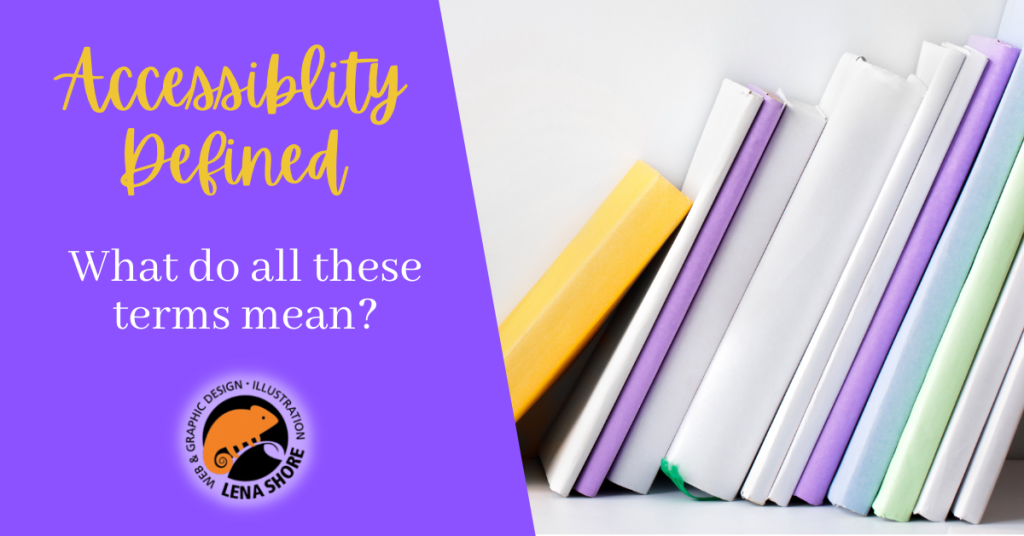Accessibility Defined. What do all these terms mean?

March 14, 2023 / Updated: March 20, 2023 / Lena Shore
Filed under: Accessibility
This is a cheat sheet of some of the terms commonly used when talking about ADA compliance or accessibility.
A11y: A shortened form of the word “accessibility.” There are eleven letters between “A” and “Y”.
Ableism: Discrimination or prejudice against individuals with disabilities.
Accessibility Barrier: Anything that prevents individuals with disabilities from fully accessing and using a product or service.
Alt text: Text that screen readers read aloud when they come upon a photo, logo, icon, chart, or other graphic.
Artifacting: Hiding unnecessary content from a screen reader. If it doesn’t need to be read aloud for the content to be understood, it should be artifacted.
Caption: A title or brief explanation under an image or appended to an article, illustration, cartoon, or poster.
Color Analyzer Tools: Are used to check the contrast between text and background colors on websites to ensure they are legible for individuals with visual impairments. Examples include: Webaim Contrast Checker, TPGi’s Colour Contrast Analyser (CCA), Color Contrast Validator for InDesign, and Adobe Color Contrast Analyzer.
Color Contrast: The amount of contrast between colors that overlap or are next to each other. Color contrast should meet the WCAG color ratio requirements. WCAG Level AAA requires a contrast ratio of at least 7:1 for normal text and 4.5:1 for large text. Large text is defined as 14 point (typically 18.66px) and bold or larger, or 18 point (typically 24px) or larger.
Color Contrast Ratio: The ratio between the color of text (or additional important visual information) and the color of the background, which must meet minimum ratio levels to ensure legibility for visually-impaired and/or color blind users.
Common Look: A tool used to check for compliance with accessibility standards. While Acrobat is a commonly used tool for this purpose, it does not meet 508 standards. There are currently no Mac-compatible checkers available.
MathJax: A software emulator that allows individuals to explore and understand equations. Mathjax Website.
Neurodivergent: A term used to describe individuals who have neurocognitive differences, such as dyslexia or autism.
Opentype (OTF): A font format developed by a joint effort between Adobe and Microsoft. It is cross-platform like TTF and can store up to 65,000 characters, allowing for features such as ligatures, glyphs, small caps, alternate characters, and old-style figures.
PDF/UA: internationally recognized PDF standards.
Prefatory Text: Text that introduces a document or section.
PWD (People with Disabilities): A term used to refer to individuals who have physical, cognitive, or developmental disabilities.
Reading Order is another way screen readers navigate a document.
Screen Readers: Screen readers are software programs that allow individuals who are blind or have low vision to access and use computer programs and websites by reading the text aloud. NVDA and Jaws are two examples of screen readers.
Section 508/508 Standards: Part of the Rehabilitation Act of 1973. A set of standards for electronic and information technology accessibility, specifically for individuals with disabilities. These standards are required by federal law.
STAMP (Standards Testing and Materials Project): A project focused on testing and evaluating materials and technologies for accessibility.
Tags are how screen readers navigate a document. They should be in the proper order for readability.
The U.S. Access Board oversees accessibility standards (that includes digital accessibility).
TLDR (Too Long, Didn’t Read): A summary of a long piece of text, usually written for readers who do not have time to read the entire document.
Truetype (TTF): A font format developed in the late 1980s by a joint effort between Apple and Microsoft. It includes both a screen font and a print font in the same file.
W3c (World Wide Web Consortium): The international community that develops open standards to ensure the long-term growth of the Web.
WCAG (Web Content Accessibility Guidelines): Internationally recognized web standards. A set of guidelines and standards for making web content accessible to individuals with disabilities. There are three levels of compliance (A, AA, AAA). AA is usually the law. WCAG is part of the W3C. WCAG Website
Web Open Font Format (WOFF): A compressed font format developed by Mozilla, Opera, and Microsoft for use on websites.
Word Prediction: A feature that suggests words as the user types, to help them complete a sentence or phrase more quickly.
This article is part of a series of monthly articles I will be posting on accessibility and how it relates to our websites and marketing materials. They will cover how it affects you, why you should care, pitfalls, and what you can do about it.